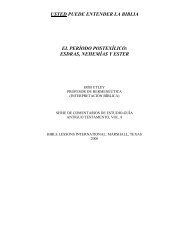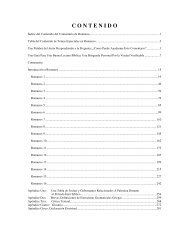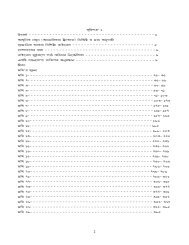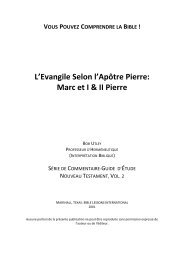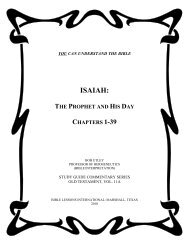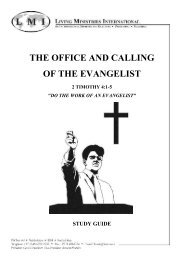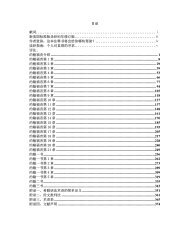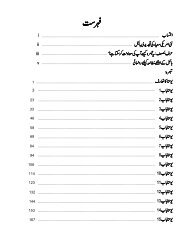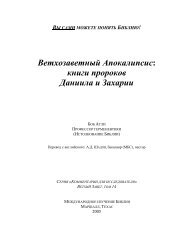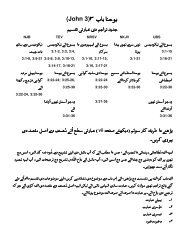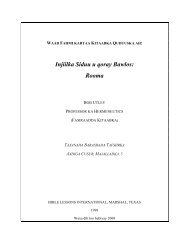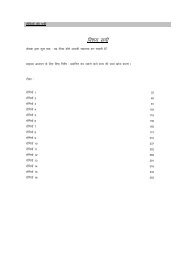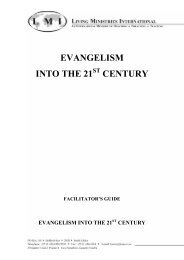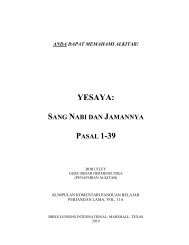Jesaja 1-39 - Free Bible Commentary
Jesaja 1-39 - Free Bible Commentary
Jesaja 1-39 - Free Bible Commentary
Create successful ePaper yourself
Turn your PDF publications into a flip-book with our unique Google optimized e-Paper software.
(1) verandering van historiese setting<br />
a. 1-<strong>39</strong> dui op Juda nog voor ‘n inval<br />
b. 40-55 weerspieël ballingskaptoestande<br />
c. 56-66 weerspieël na-ballingskap toestande<br />
d. 1-<strong>39</strong>, die tempel sal vir altyd staan, maar volgens 40-66 het die tempel reeds geval en bevind die<br />
skrywer hom in ballingskap.<br />
(2) Die wisselende terme om God se uitverkorenes te beskryf<br />
a. die Messiaanse kind<br />
b. die Lydende Kneg<br />
(3) Terme oor Israel<br />
a. vrou (50:1)<br />
b. diensknegte van JHWH (54:17)<br />
5. Eietydse konserwatiewe geleerdes<br />
a. E. J. Young maak ‘n waardevolle stelling i.v.m. hoofstukke 56-66: “another possibility is that Spirit-led,<br />
editor-collected prophecies from different prophets of the Isaiah school around basic themes of this<br />
section,” (bl. 188).<br />
b. R. K. Harrison se siening: “The present writer holds to the view that Isaiah, like the majority of the other<br />
extant prophetic writings, represents an anthology of utterances given at various times, and as such the<br />
work merits no different treatment from that accorded the other major prophecies. In this connection it is<br />
important to note that arguments based upon differences of style or literary expression are immediately<br />
vitiated by this approach, since an anthology may be taken quite fairly as representing the total style of<br />
the author over the different periods of creative activity. Justification for describing the work as an<br />
anthology in the best sense of that term, is furnished by the opening verse of the prophecy, which<br />
constitutes a heading for the work and speaks specifically of the revelatory material that Isaiah the son of<br />
Amoz received in visions concerning Judah and Jerusalem in the days of Uzziah, Jotam, Ahaz, and<br />
Hezekia. As with all anthologies it is fairly evident that the book contained only a selection of the<br />
available prophetic oracles and sermons, and it is highly probable that Isaiah produced considerably more<br />
material than has survived in this book. The nature of the prophecy as an anthology is further indicated<br />
by the presence of superscriptions in Isaiah 2:1 and 13:1, which may have represented, or pointed to the<br />
presence of, earlier collections of prophetic utterances,” (bl. 780).<br />
6. Daar is ‘n verskil in literȇre styl wat betref 1-<strong>39</strong> en 40-66.<br />
E. Samevattende opmerkings oor outeurskap<br />
1. Godvresende geleerdes verskil onder mekaar oor hoe die boek <strong>Jesaja</strong> in sy huidige vorm tot stand gekom het<br />
(sien bv. die Dooie See-rolle en Masoretiese Teks). Die hoofklem moet egter op die geїnspireerdheid van die<br />
boek geplaas word, op die betroubaarheid daarvan, ook wat betref openbaring van die karakter van JHWH.<br />
2. Ons moet alle voorveronderstellings wat God se openbaring deur <strong>Jesaja</strong> betwyfel, verwerp. Daarmee word<br />
ook bedoel die verwerping van die uitgangspunt wat by voorbaat voorspellende profesie nie aanvaar nie, wat<br />
daarmee die OT as bloot mensewerk beskou en slegs van historiese en tydgebonde waarde.<br />
VI. DATERING<br />
A. <strong>Jesaja</strong> was werksaam in geledere van die 8ste eeuse profete.<br />
1. Jona, Amos, Hosea in die Noordelike Ryk (Israel), tydens regering van Jerobeam II (786-640 v.C.)<br />
2. <strong>Jesaja</strong> en Miga in die Suidelike Ryk (Juda).<br />
B. Hy is gebore in ongeveer die jaar 760 v.C. en ontvang sy roeping as profeet ongeveer 742 v.C. d.w.s. in die<br />
sterfjaar van koning Ussia (6:1). Ussia word ook Asarja genoem (783-742 v.C.)<br />
C. <strong>Jesaja</strong> het ‘n lang bediening gehad. Van Ussia se laaste jare (voor 742 v.C.), regdeur Jotam se tyd (742-735 v.C.),<br />
ook dié van Agas (735-715 v.C.), Hiskia (715-687 v.C.) en tot in die regeringstyd van Manasse (687-642 v.C.),<br />
want hy voorspel nog Sanherib se dood in hoofstuk 37:38 in 681 v.C.<br />
D. R. K. Harrison verklaar dat die boek ‘n bloemesing van die profeet se uitsprake en preke tydens die regeringsjare<br />
van verskeie Judese konings is en teen 630 v.C., na sy dood, saamgestel en redaksioneel versorg is.<br />
VII. DIE HISTORIESE TYDGEWRIG VAN AGSTE-EEUSE PROFETISME<br />
A. Gegewens uit die Bybel is te vinde in<br />
1. 2 Kon. 14:3-17:6<br />
2. 2 Kron. 25-28<br />
3. Amos<br />
4. Jona<br />
5. Hosea<br />
6. <strong>Jesaja</strong><br />
7. Miga<br />
B. Die duidelikste beeld oor die staat van afgodery onder die volk van God word in Hosea beskryf (uit NAV geneem<br />
– vert.):<br />
3



